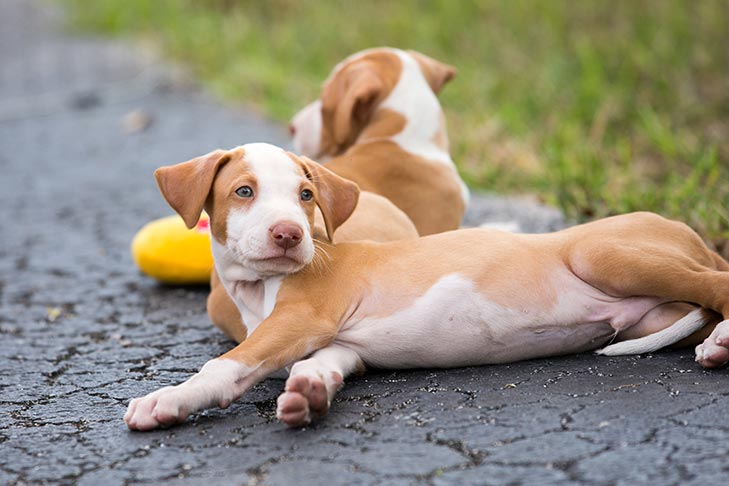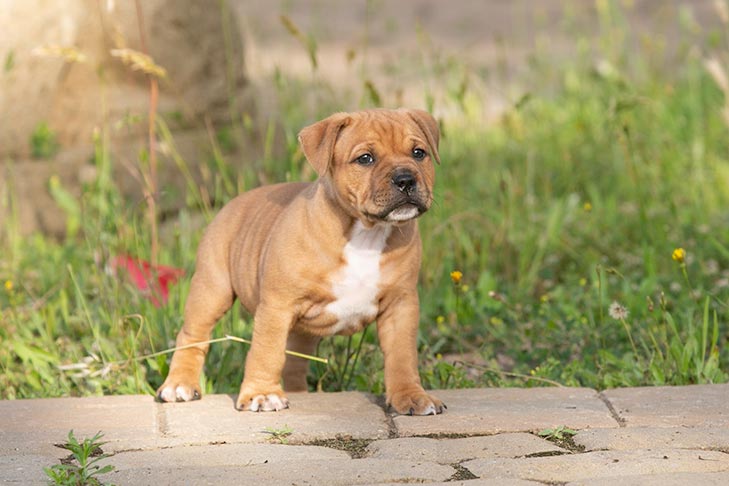
Puppies have a short time window for optimal socialization, and that requires exposure to multiple different surfaces, people of all backgrounds, and various new situations. But what about the puppies who happen to be within that window now, during this time of necessary social distancing due to COVID-19? How can they be socialized so they can grow to be confident and happy dogs for the rest of their lives?
The Goals of Socialization
First, it’s important to keep in mind the goals of puppy socialization. Paul Owens, professional dog trainer and bestselling author of The Dog Whisperer books, points out that “socialization does not mean putting a dog in a new situation and seeing what happens. Socialization means introducing new situations and making them safe, positive, confidence-building experiences.”
Certified dog trainer and CGC evaluator Jacqui Foster, CPDT-KA, agrees: “As one of my mentors says, ‘Absence of one bad experience far outweighs 100 good experiences!'” She adds that each puppy learns differently, so “work with the dog in front of you … I tend to lean more towards developing self-confidence in the puppy, rather than flooding the dog with loads of people, noises, and experiences.”
The Most Important Exposures for Your Puppy
There are certain new situations to which all puppies should be exposed if possible, preferably during the first 16 weeks of life, and the good news is that most of these can be accomplished in and around your own home. Each positive experience builds your puppy’s self-confidence. These exposures include:
- Different surfaces: grass, leaves, concrete, gravel, linoleum, carpet, wood, sand, etc.
- Different sounds: think of all the everyday sounds around your home, including hairdryers, phone ringtones, radios, vacuum cleaners, and more. There are even recordings of sounds like thunder and other dogs barking that you can download for your puppy to hear. Be sure to make each noise exposure a positive experience by acting happy around the sound and associating the sound with yummy treats, and watch your puppy for any signs of stress.
- Other dogs: this can be done if you have other dogs in the neighborhood you know and trust to be safe and well-mannered with your puppy. It will be important for you to know the other dogs’ owners as well; the best-case scenario would be to have a trusted, healthy friend who is also a dog owner, as you could then arrange safe play dates with the other dog while maintaining a safe distance from the other owner (more on this below).
- Other people: this may be the most difficult of all at this time, but there are still ways to achieve this exposure for your puppy. Certainly have your puppy socialize with all the members of your household who are healthy. You can also let your puppy look out the window of your home as other people go by, and let your puppy see you act happy about those people. Also, consider all that your puppy can see and hear from the safety of your own car.

Safe Puppy Play Dates and Walks
Your first worry may be that your puppy can pick up or spread COVID-19 to you or other humans. However, statements from the World Health Organization (WHO), the Centers for Disease Control and Prevention (CDC), and the American Veterinary Medical Association (AVMA) have all emphasized that, based on the available evidence, dogs cannot transmit COVID-19 to humans.
Kelly L. Moore, MD, MPH, is a medical epidemiologist and public health physician with expertise in pandemic planning and response; she trained at the CDC as an Epidemic Intelligence Service (EIS) officer. She notes the importance of paying close attention while out on a walk so as to maintain your own six feet of space from the nearest human being—that’s the length of a six-foot leash—and, above all, the vital importance of washing your hands for at least 20 seconds after every encounter.
Dr. Moore adds, “It’s helpful to identify trusted friends that you know will tell you if they develop any symptoms of illness and that you can trust when they say they’re feeling well, who can spend time with your puppy.”
She also notes that “being outside is a great thing for people to do. The outside is an open environment with air that’s well-circulated; you’re able to stay more than six feet apart, so that’s a good environment for puppies to socialize in. I would have no issue with someone petting my puppy if they’re also healthy and have no symptoms [as long as] when you come back in from your walking and socializing, you wash your hands thoroughly.”
Crate Training Is Still Important
Even though you may currently be at home all day, your puppy still needs a structured schedule to reduce stress on everyone and to let the puppy know what is expected. Trainer and dog sports enthusiast Alexa Hagood, LVMT, states that this is a good opportunity to institute periods of “alone time,” like crate and nap breaks, so the puppy doesn’t develop separation anxiety when you do return to your place of work. Crate training can be an invaluable tool for your puppy at this time, just as with any other time.
As Hagood puts it, “Just because someone is home with the puppy, doesn’t mean they need to be with the puppy 24/7. Crate breaks, even when brief, can help the puppy become acclimated to going in the crate and having some alone time, even when people are home.” She recommends starting with feeding times inside the crate (for five to ten minutes), and when the owner needs to do daily chores.
Is This a Good Time to Get a Puppy?
While Dr. Moore acknowledges that puppies can be a wonderful source of joy and distraction during stressful times, Paul Owens suggests thinking hard and being extra prepared if this will be your first puppy. He notes that “all the things related to having a new puppy, like vet visits, grooming, and socialization, can be more of a challenge” at this time. He adds, “But the first thing I would suggest, if a dog does come into a home, is to contact a professional trainer.”
Enlisting the help of a professional trainer can still be done during social distancing—you can do so over the phone or via online sessions, which many trainers are now offering. For example, AKC GoodDog! Helpline is live telephone service that connects you with a professional trainer. The trainer will offer virtual, individualized advice on everything from house-training to behavioral issues.
Yasmine S. Ali, MD is a cardiologist and writer in Tennessee, where she lives with three Canine Good Citizens.
Need help with your adorable new puppy? Training your dog can be challenging without expert help. That’s why we’re here to help you virtually, through AKC GoodDog! Helpline. This live telephone service connects you with a professional trainer who will offer unlimited, individualized advice on everything from house-training to behavioral issues.

